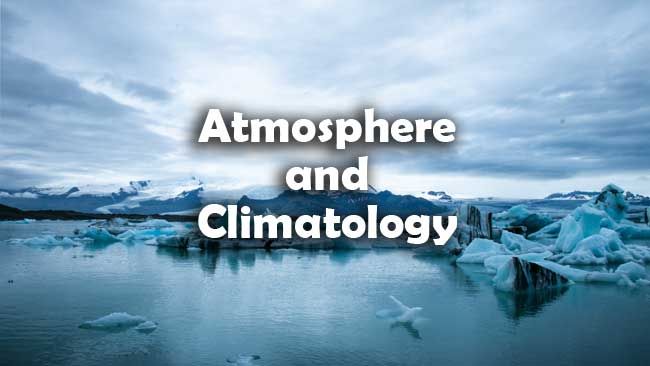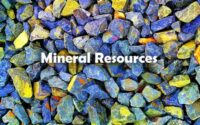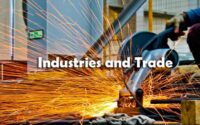Atmosphere and Climatology
Atmosphere and Climatology Questions and Answers Papers pdf will be available here for download. Therefore, all the contenders can make use of this chance and start to download the Atmosphere and Climatology Solved Question Papers.

Because by solving the Atmosphere and Climatology Objective Model Papers you can improve your knowledge. Also, check for download the Atmosphere and Climatology MCQ Papers with Solutions from the link provided below. The Atmosphere and Climatology Quiz helps you to prepare well for the exam topic wise and obtain very good marks.
Therefore, go through this post thoroughly and download the Atmosphere and Climatology Last Year Question Papers. All these questions on Atmosphere and Climatology are collected from previous year papers and compiled by us.
Questions and Answers on Atmosphere and Climatology
1. Which one of the following is not the example of planetary winds ?
(A) Monsoon
(B) Trade wind
(C) Land and sea breezes
(D) Chinook
2. The climate of North America is influenced during winter by the
(A) Polar airmasses
(B) Warm airmasses
(C) Continental airmasses
(D) Tropical airmasses
3. Storms of gases are visible in the chromosphere of the Sun during
(A) Cyclones
(B) Anticyclones
(C) Lunar eclipse
(D) Solar eclipse
4. Recharging of water table depends on
(A) amount of rainfall
(B) relief of the area
(C) vegetation of the area
(D) amount of percolation
5. In atmosphere the lowermost layer is
(A) Troposphere
(B) Exosphere
(C) Ionosphere
(D) strato sphere
6. The lower layer of atmosphere is called
(A) Exosphere
(B) Troposphere
(C) Ionosphere
(D) mesosphere
7. Which is the lowest layer of the atmosphere?
(A) Troposphere
(B) Stratosphere
(C) Mesosphere
(D) Thermosphere
8. Which one of the following represent the lines joining the places of equal rainfall ?
(A) Isohypses
(B) Isohalines
(C) Isobars
(D) Isohyets
9. Depression formed due to deflating action of winds are called
(A) Playas
(B) Yardang
(C) Ventifacts
(D) Sand dunes
10. Which one of the following is the highest cloud ?
(A) Cirrus
(B) Stratocumulus
(C) Nimbostratus
(D) Cumulus
11. Troposphere is the hottest part of the atmosphere because
(A) it is closest to the Sun
(B) there are charged particles in it
(C) it is heated by the Earth’s surface
(D) heat is generated in it
12. The lowest layer of the atmosphere is :
(A) Stratosphere
(B) Thermosphere
(C) Troposphere
(D) Mesosphere
13. The zone of Earth’s atmosphere immediately above its surface up to a height of about 16 kms above equator and 8 kms over the poles is known as :
(A) Mesosphere
(B) Thermosphere
(C) Troposphere
(D) Stratosphere
14. Which one of the following is called as “Roaring Forty”?
(A) Winds blowing in southern hemisphere between 400–600 S
(B) Winds blowing in northern hemisphere between 400–600 N
(C) Very cold winds which blow in winters
(D) Very hot and fast blowing summer winds
15. Airmass near to the earth’s surface is warmer because it
(A) radiates heat
(B) contains dust particles
(C) is warmed by terrestrial radiation
(D) is far from the sun
16. Which one of the following is called North-easter?
(A) Cold and fast-blowing winds in northern hemisphere that move from sub-polar to polar regions
(B) Cold and fast-blowing winds in South Pole region
(C) Cold and fast-blowing winds from the polar region in northern hemisphere
(D) Winds blowing towards Kazakhstan in Central Asia
17. Density of the earth’s atmosphere is highest in the
(A) Troposphere
(B) Stratosphere
(C) Mesosphere
(D) Ionosphere
18. Which of the following absorbs part of the insolation and preserves earth’s radiated heat?
(A) Oxygen
(B) Nitrogen
(C) Water vapour
(D) Carbon-di-oxide
19. Cyclones are caused due to
(A) low pressure
(B) high pressure
(C) low temperature
(D) high density
20. What is a ‘tornado’ ?
(A) A very high pressure centre
(B) A very low pressure centre
(C) A very high ocean wave
(D) A planetary wind
| Physical Geography | Atmosphere |
| Bio Geography | Earth landform |
| Soil Geography | Universe and Solar System |
| Hydrosphere |
21. Katrina is the name given to _________
(A) Satellite
(B) Star
(C) Heat wave
(D) Hurricane
22. In which region does rainfall occur throughout the year ?
(A) Mediterranean
(B) Equatorial
(C) Tropical
(D) Temperate
23. Condensation is the reverse of
(A) Vaporization
(B) Smog
(C) Cirrus cloud
(D) Fog
24. Daily weather changes in the atmosphere are associated with
(A) Troposphere
(B) Mesosphere
(C) Ionosphere
(D) Stratosphere
25. Tropical storm in Chinese Sea is known as–
(A) Wave
(B) Tornado
(C) Typhoon
(D) Cyclone
26. Convectional Rainfall occurs in:
(A) Equatorial region
(B) Temperate region
(C) Tropical region
(D) Polar region
27. Land and sea-breezes occur due to :
(A) Conduction
(B) Convection
(C) Radiation
(D) Tides
28. Trade winds blow from the
(A) equatorial low pressure
(B) polar high pressure
(C) subtropical high pressure
(D) subpolar low pressure
29. Equatorial regions experience
(A) warm and dry climate
(B) hot and humid climate
(C) wet and windy climate
(D) moderately pleasant climate
30. What happens to atmospheric pressure with increase in altitude?
(A) It remains constant
(B) It decreases
(C) It increases
(D) It constantly fluctuates
31. Mediterranean type of climate is characterized by
(A) dry summer and wet winter
(B) wet summer and dry winter
(C) dry summer and dry winter
(D) wet summer and wet winter
32. Which of the following winds is called anti-trade wind ?
(A) Chinook
(B) Cyclone
(C) Typhoon
(D) Westerlies
33. The solar radiation coming to Earth is called
(A) Radiant energy
(B) Insolation
(C) Sunshine
(D) Terrestrial radiation
34. Hailstorms are caused due to
(A) Condensation
(B) Convection
(C) Sublimation
(D) freezing
35. Blizzards are characteristic features of—
(A) equatorial region
(B) tropical region
(C) Antarctic region
(D) temperate region
36. If there is no carbon dioxide in the earth’s atmosphere, the temperature of earth’s surface would be
(A) dependent on the amount of oxygen in the atmosphere
(B) higher than the present
(C) less than the present
(D) the same
37. Name the continent where ‘Tundra’ type of climate is not found
(A) Europe
(B) Asia
(C) Africa
(D) North America
38. The vertical movement of air is termed as
(A) Wind
(B) air current
(C) air turbulence
(D) air mobility
39. The atmospheric layer closest to the earth is:
(A) Mesosphere
(B) Hydrosphere
(C) Troposphere
(D) Ionosphere
40. Frontal Rain is caused by
(A) Convection current
(B) Winds from sea
(C) Cyclonic activity
(D) Condensation of water evaporated from mountains
41. Smog is a combination of
(A) air and water vapour
(B) water and smoke
(C) fire and water
(D) smoke and fog
42. Which one of the four regions above the earth has smallest height (km.) ?
(A) Stratosphere
(B) Mesosphere
(C) Thermosphere
(D) Troposphere
43. Typhoons are common in the
(A) Arctic Ocean
(B) Seas of China and Japan
(C) Mexican Gulf
(D) Indian Ocean
44. Wind rose represents
(A) wind turbulence
(B) wind data
(C) wind pressure
(D) wind temperature
45. The layer of the atmosphere in which Radio Waves are reflected back is called ;
(A) Ionosphere
(B) Troposphere
(C) Stratosphere
(D) Exosphere
46. The atmospheric layer farthest from the Earth’s surface is known as
(A) Stratosphere
(B) Exosphere
(C) Ionosphere
(D) Mesosphere
47. The climatic zones are classified on the basis of
(A) distance from the equator
(B) elevation
(C) rainfall
(D) distance from the sea
48. The main advantage of Rain Water Harvesting (RWH) is
(A) Recharge ground water
(B) Avoid floods
(C) Reduce the loss of water
(D) Avoid soil erosion
49. Subtropical high pressure belts are otherwise called
(A) Furious fifties
(B) Screeching sixties
(C) Horse latitudes
(D) Roaring forties
50. Atmospheric temperature increasing at the higher altitudes is called
(A) Radiation
(B) Inversion
(C) Conduction
(D) Convection



